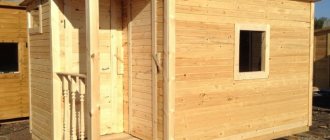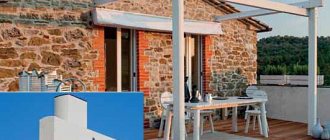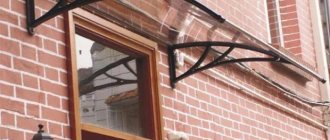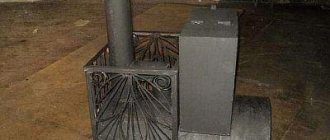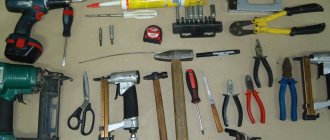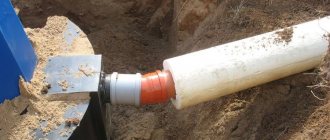In our homes there are often such doorways that become problematic to install because of their size and shape. Also, in some rooms there is no need to install doors at all.
However, few people like to leave them in the form of a rectangle, and therefore, for aesthetics, arches are made from them. The simplest and most effective solution is to use drywall for these purposes. This material is easy to process, and the installation technology is not particularly complicated.
Today we will tell you how to make a plasterboard arch with your own hands. We will touch on all the nuances of the process, from preparation to the subtleties of finishing this element.
DIY plasterboard arch
Design selection
Hanging structures are different and differ from each other in the type of support system and the shape of the rafter structure. Which one to choose depends on the size of the site, its distance from a house or other building, and the number of vehicles requiring covered parking.
Support system
Depending on the type of installation of the supports supporting the canopy, it can be free-standing or attached. How to calculate a canopy from a profile pipe based on the amount of material required for the frame largely depends on the chosen design.
- A separate shelter for a car is not connected to other buildings; its roof rests with all its weight on vertically installed supports.
- Attached structures are attached on one, two or even three sides to the main walls of buildings and fences and have only additional vertical supports under free overhangs (or do not have them at all).
Attached canopy without vertical supports Source ibb.co
Rafter system
The rafter system refers to the shape of the roof, which can be single-pitched, double-pitched or arched.
- Single-pitch.
The simplest design is with a flat roof, one edge of which is located higher, forming the desired slope. Attached canopies can rest on the wall on any side - both straight and inclined. Such a roof can be covered with any material, and the rafter system does not require complex calculations. If you need to cover a platform of small width, it will consist only of rafter legs resting on transverse horizontal crossbars. In the case of a wide parking lot, the rafter system is made in the form of trusses in the shape of a right triangle.
Diagram of the metal frame of a single-pitch free-standing canopy Source krovlyakryshi.ru
- Gable.
This design has two flat slopes connecting at an angle at the ridge. The supporting truss can be made in the form of an equilateral triangle filled with additional supports and slopes to increase stability. But other options are also possible - with raising the lower belt. In installation, it is not much more complicated than a single-slope one.
Gable canopy truss with parallel truss chords Source jimcdn.com
- Arched.
The most difficult option is how to weld a canopy from a profile pipe with your own hands, since the roof trusses need to be given the same curved shape. For this you need a special pipe bending machine. Only flexible roofing material is suitable for this design. As with gable canopies, trusses are made with a horizontal or curved bottom chord.
The internal stiffening ribs of arched trusses are often made curly Source ytimg.com
See also: Catalog of companies that specialize in the installation of metal structures of any complexity.
Complex design solutions
Nowadays, arches with unusual shapes are becoming increasingly popular.
Naturally, frames designed for arches in the shape of a regular arc are not suitable for such unusual and original designs. To make a complex bend or give an original shape to an arch, you need to do the same with the frame itself, which is much more difficult. Arches are often made in the Gothic, Rococo and other styles that are experiencing a revival these days.
Creating such original openings on your own can be a rather difficult and almost impossible task, so it is best to seek help from professionals.
Frame elements made of corrugated pipe
Before building a carport from metal profiles and corrugated sheets or other roofing material, you need to perform basic calculations and select the pipe section for each structural element.
Profile pipes have a square or rectangular cross-section with certain parameters and different wall thicknesses. The load-bearing capacity of products directly depends on them. Their strict geometric shape facilitates the work of assembling or welding the frame, allowing for precise joining of parts.
The frame for the canopy is assembled from the following elements:
- vertical support pillars;
- horizontal crossbars or side trusses connecting supports;
- load-bearing roofing system in the form of trusses or rafter legs;
- sheathing to which the roofing material is attached.
Arched canopy project Source likservis.ru
The choice of corrugated pipe section for each element depends on its functions and the dimensions of the structure. Since you need to build a canopy from a metal profile with your own hands for a car in such a way that it provides free parking and comfort for the driver getting out of the car, its width must be at least 4.5 meters.
It is advisable to cover a span of this length with trusses, and not with individual rafters, which are vulnerable to load in the part where they are not supported. Trusses have sufficient rigidity due to the fact that they consist of multidirectional elements. The load on them is distributed more evenly.
The recommended parameters of profile pipes for different load-bearing frame elements are given in the table.
| Canopy width, m | Support posts (section/wall thickness), mm | Rafter system (section/wall thickness), mm |
| 4-4,5 | 40x40 / 2 | 25x40 / 2 |
| 4,5-5,5 | 60x60 / 3 | 40x40 /2 |
| more than 5.5 | from 80x80 / 3 to 120x120 / 3 | 30x60 /2 or 40x40 /2 |
To strengthen the trusses and sheathing, it is allowed to use products of a smaller cross-section: 20x20 mm, 20x40 mm. They do not take on any special load, but serve to distribute it evenly and ensure structural rigidity.
Profile pipes of different sections Source maja-dacha.ru
List of required materials
Construction process
To carry out the work, first prepare the following materials:
- reinforcement rod, diameter (this icon will be used later in the text - Ø) 10 mm, length 6 m - 2 pcs.;
- reinforcement rod (Ø mm), length 0.94 m – 9 pcs.;
- strong wire, soft;
- enamel for painting and primer;
- reinforcement (Ø 10 mm), 0.25 m long, as pins for a template - 10 pcs.;
- rope 1 m long.
Design and calculations
Before you calculate a canopy from a profile pipe with your own hands, you need to sketch out its sketch with the main dimensions, decide on the shape of the roof, and how to install the supports.
- If the parking area does not have a hard concrete surface, the pillars are installed by digging into the ground. Therefore, the length of the supports is calculated taking into account this depth.
- When installing on a finished coating, mounting pads with holes are welded to the lower ends of the supports and secured with anchors.
- If construction begins with a covering, you can install metal embedded parts in it in advance and weld the supports to them.
In the last two cases, the length of the support pillars is equal to the height of the canopy from the ground level to the truss attachment points.
Lathing on the walls
So, let's make a frame for the wall:
- We step back from the wall a few centimeters, see if there are any larger protrusions on its plane, and put a mark on the ceiling in the left corner.
- In the right corner along the ceiling we retreat the same distance and put a mark.
- We transfer the points to the floor.
- We connect them along the entire perimeter of the wall.
- We mount guide rails along the resulting lines.
We mark the wall for mounting hangers:
- We place marks along the lower and upper horizontal rails every 60 cm.
- Connect the dots along the wall using upholstery thread.
- Along the guide vertical slats on both sides of the wall we place marks from bottom to top every half meter.
- We repeat point 2.
As a result, you should get a grid on the wall, at the intersection of the lines of which you need to attach hangers.
After the suspensions are fixed, we take the supporting rails and insert them into the grooves of the lower and upper guides.
But now the wall frame needs to be leveled. It is easier to do this with ordinary construction threads, which are pulled between two vertical profiles every half a meter. At this point, the do-it-yourself wall frame for plasterboard is ready.
Video description
Other options for installing supports are also possible: to the walls of the building, fence posts, etc.
Designing a canopy attached to a house is shown in this video: The next step in how to calculate a canopy from a metal profile is to determine the length of the pipes for making trusses (or rafter legs). For pitched structures, you need to know the angle of inclination of the slopes, which is selected taking into account the wind and snow load in the construction region.
- For a pitched roof, 8-15 degrees is sufficient.
- For gable slopes in areas with strong winds 15-22 degrees.
- For a gable slope in snowy regions 25-30 degrees.
The length of the rafters is calculated using a simple trigonometric formula: c=b/cosA, where B is the width of the canopy, A is the angle of inclination of the slope. The height of a triangular truss is found similarly.
Drawing for determining the length of the slope Source ibb.co
Note! If a gable canopy is being designed, half of its width is substituted into the formula.
The arc length for an arched structure can be determined by knowing the height of the arch h. The following formula is used for this:
c = (h + b/2) x 1.57
And the last design parameter that needs to be determined in order to know how to weld a frame for a canopy is the step between the supports and the trusses. Usually it is selected in the range from 1 to 2 meters, depending on the massiveness of the roofing, and a truss is attached between each pair of supports. If the distance between the pillars is greater, the structure will need to be reinforced with side trusses. It is not recommended to increase the pitch between the rafters.
Project of a canopy with sparse supports and side trusses Source dilpy.ru
What is better not to do?
Using a manual pipe bender to create an arched element from a profile, in most cases, the result is of insufficient quality and the desired result. All this happens because such a device is suitable for deforming small pieces of profile products with small cuts. Unfortunately, large and identical arched parts cannot be completed. Although there are such skilled workers who, even in such a difficult way, create the necessary details. But for a beginner in this business, it’s better not to take risks. For those who have never encountered this type of work, there are more suitable, understandable and high-quality ways to create an arched metal part. In addition to the described deformation option, there is another one that involves a trimming process. The disadvantages of this method include the fact that after such work the deformed product becomes not very neat. Only because of this, the method of cutting and bending profile pipes followed by the welding process is used when the appearance of the finished part is absolutely not important. A special machine for bending profile pipes belongs to the technical equipment of production. Even he sometimes cannot reproduce everything he has planned. In addition, such a machine can only be used in an industrial environment. In the private sector, located on a plot of land, such a machine is simply inappropriate. In addition, a one-time order may not turn out to be of very high quality, since it is quite problematic to configure the device for each part with absolute accuracy. In this case, the radius parameters of the profile arched element may turn out to be unequal, and its sidewalls may be turned in different directions. If it is necessary to create metal arches in large quantities, it is recommended to use the help of specialized companies by ordering the service of bending profile products using special equipment.
Creating profile deformations yourself
You can find a way out of the situation with creating profile arched elements by using some familiar methods. Of course, professionals who deal with massive bending of profile pipes every day will not appreciate them. But in order to improve the local area and greenhouse structures, such options for creating arched parts are acceptable and appropriate.
Construction of a canopy
First you need to decide how to build a carport from a metal profile: by welding or bolted assembly. Welding is more reliable, but not everyone knows this method or a welding machine. However, this is not a reason to abandon the metal frame.
Frame with bolted and shaped connections Source ccd.by
Frame making
Construction begins with leveling the site and marking for the installation of pillars. If they are to be concreted, holes with a depth of at least 70-80 cm are drilled at the marking points. Their diameter should be 10-20 cm larger than the cross-section of the supports.
The bottom of the holes is covered with sand, pillars are installed in them and they are leveled vertically. Approximately half the depth of the hole around the supports is filled with fine crushed stone, compacted, then concrete prepared from 1 part cement, 2 parts sand and 2 parts crushed stone is poured.
On a note! Instead of crushed stone and sand, you can take 4 parts of sand and gravel mixture.
To prevent the pillars from leading, while the concrete hardens, they are tied together with temporary jibs or crossbars, fixed in a vertical position. Before welding the canopy, the concrete must be allowed to gain strength, which will take from 5 to 10 days, depending on weather conditions. This time can be spent on making trusses and other structural elements of the frame.
When concreting pillars, it is necessary to control the line of their installation along a stretched cord Source ytimg.com
Video description
You can see how to weld a canopy for a house from a profile pipe under corrugated sheeting in the video:
Roof installation
When the load-bearing base of the frame is ready, the sheathing is attached across the trusses. It can be either metal or wood. The wood must be treated with an antiseptic before laying on the rafters. All metal parts of the structure are also protected from corrosion using primer and paint.
Various materials are used as roofing for carports: corrugated sheets, metal tiles, ondulin, cellular polycarbonate.
Profiled sheets are laid in the direction from the lower overhang to the ridge or the upper line of the canopy with an overlap of one wave. And they are fixed with roofing screws with a rubber gasket.
Polycarbonate is mounted in longitudinal strips along the overhang so that the condensate formed in it flows to the bottom. It is joined end-to-end using special H-shaped profiles, secured with self-tapping screws with thermal washers, and the ends are covered with a perforated U-shaped profile.
Fastening cellular polycarbonate Source ytimg.com
Tools for work
A plasterboard arch has the simplest structure and you don’t need any unusual tools to make it - the basic ones will probably be found in your “bins” if you are a business person, and the rest can be purchased at reasonable prices. Below is a table that lists everything you need.
Table 1. Required tools
| Photo, instrument name | What is it used for? |
Hammer | Using a hammer drill, you can easily drill holes in concrete and brick walls. We will need it if we work with these surfaces. You can use the simplest tool, since you will have to make no more than 10-15 holes per arch. |
Screwdriver | This tool is essential when working with drywall. With its help, the frame elements are connected, and the material itself is hemmed. It is recommended to work with a device that has high torque. This property makes it easier to screw screws into metal. |
Bubble level | In order for the structure to turn out beautiful and geometrically correct, it is necessary to constantly use a building level when assembling it. The instrument may be small, the main thing is that it shows as accurately as possible. |
Drywall rasp | A rasp is used to level the cut areas of the drywall. For the arch you will need this rounded version. This device costs around 100 rubles in any hardware store. |
Metal scissors | They are needed to cut metal profiles. We recommend a tool with a double lever - it cuts easily, without much effort on your part. |
Stationery knife | Using a utility knife, it is very easy to cut drywall in a straight line. It will be useful when cutting blanks for an arch. |
Electric jigsaw | When making an arch, it is necessary to perform shaped cutting of drywall. For these purposes, you can use any files, but it is most convenient and quick to work with a power tool. |
Carpenter's square | With this simple tool we can make the two sides of the arch identical. You will learn how this is done a little later. |
Marking tool | We will also need a small set for marking sheets of drywall: a tape measure, a pencil, nylon thread (wire or a piece of profile) and a self-tapping screw. |
Interesting to know! We will need the last three things from the list in order to make a homemade compass.
As you can see, there is nothing unusual on the list. You should also add puttying tools here - a spatula and a grater. We will tell you how this is all applied a little later.
Briefly about the main thing
There are many options for how to build a canopy from metal profiles. It can be freestanding or attached to a house or garage, and have a single-pitched, double-pitched or arched shape.
Profile pipes for the frame must have a cross-section and wall thickness corresponding to the design load. The most powerful are the support pillars, which take on the entire weight of the structure.
The cross-section of the rafter legs is selected depending on the width of the canopy. Preference is given not to single rafters, but to more rigid trusses.
The sheathing for fastening the roofing is also made from small-section corrugated pipe or wooden blocks.
The frame can be assembled either by welding or using bolts.
Ratings 0
Other types of arches
Arch made of plastic pipes
Other arches are made using exactly the same principle. For example, wooden arches are made from timber. This is a simple and inexpensive structure. Thanks to the natural material, it fits well into the design of any garden. To build such an arch, you need 2 vertical frames, 2 inclined and 1 horizontal part. All this is connected by wooden crossbars using nails. The finished structure is dug into the ground, primed and varnished.
Plastic arches are a structure made of plastic pipes. Such arches are considered the simplest to manufacture; they are easy to assemble and disassemble. If you want to make yourself a structure of this type, then you need to take into account that plastic is not able to withstand low temperatures, so such structures are often made collapsible. Such an arch is decorated with annual plants.
Forged arched structures and pergolas are very popular. Such arches look very elegant and will decorate your summer cottage all year round. Moreover, they are durable and resistant to different weather conditions. To make your stay in the garden more comfortable, you can make an arch with a bench. In this case, you can enjoy the beauty of your garden while sitting under the arch. As you can see, there are a lot of options, you just need to put in the effort and imagination, then your garden will look like a real embodiment of your ideas.
You may be interested in answers to other questions discussed on our website:
- How to improve your garden plot
- How to make an alpine slide
- How to plant flowers correctly
- How to make a decorative fence
- How to make a living gazebo

